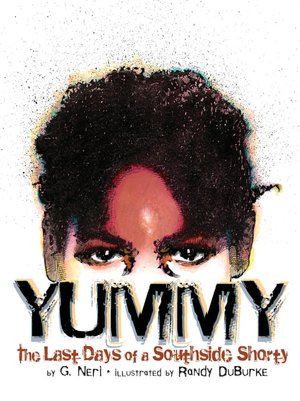Neri, G. Yummy: The Last Days of a Southside Shorty. New York: Lee&Low, 2010.
Audience: Middle School, 12+
Genre: Graphic Novel, Urban/Street Fiction, Teen Problem Novel, Boy Book
Topics of Focus: Teen Boys, Gangs, Incarceration, Choices, Violence, Judicial System, Class Disparities
Red Flags: Graphic Violence
I remember reading the 1994 Time article about the life and world of Robert “Yummy” Sandiford. It was a world I didn’t know, didn’t travel in, and didn’t want to experience. I was working with significantly-at-risk students at the time. They were Madison’s toughest. They thought they were street-saavy. They thought they were smart. Some were a little like Yummy, feeling invincible. This story could have showed them another facet of the street life in a format more accessible than the Time article I shared with them.
G. Neri’s award-winning Yummy: the Last Days of a Southside Shorty is a sad shock to the white, middle-class mindset.
It’s a window into another world of violence, street war, drugs, and youth caught up in a system they are not ready to understand. Set in the real streets of Chicago, eleven-year-old Yummy’s story is told through the voice of a classmate. In stark, black and white images, the graphic novel form sets off the colorless world of this urban youth. Yummy never met his father who was in prison for drug dealing. His mother was regularly in and out of jail for drugs and prostitution. He lived with his grandmother and sometimes up to 20 other grandchildren. He was easily overlooked and neglected. Street crime was his world. This little boy quickly became part of another predatory family system, the gangs. His acts of crime and violence escalated within this institution until culminating in his lethal shooting of a classmate. To protect itself, his gang turned on Yummy, carrying out the execution that the legal judicial system could not.
It’s a window into another world of violence, street war, drugs, and youth caught up in a system they are not ready to understand. Set in the real streets of Chicago, eleven-year-old Yummy’s story is told through the voice of a classmate. In stark, black and white images, the graphic novel form sets off the colorless world of this urban youth. Yummy never met his father who was in prison for drug dealing. His mother was regularly in and out of jail for drugs and prostitution. He lived with his grandmother and sometimes up to 20 other grandchildren. He was easily overlooked and neglected. Street crime was his world. This little boy quickly became part of another predatory family system, the gangs. His acts of crime and violence escalated within this institution until culminating in his lethal shooting of a classmate. To protect itself, his gang turned on Yummy, carrying out the execution that the legal judicial system could not.
Annotation by Denise Aulik

No comments:
Post a Comment